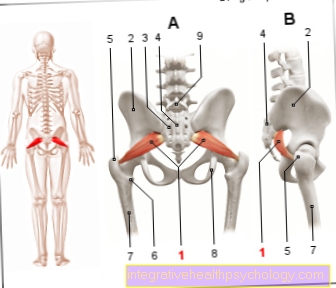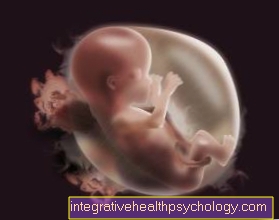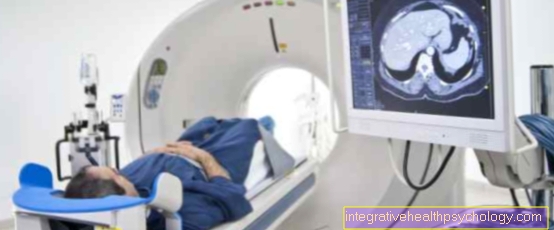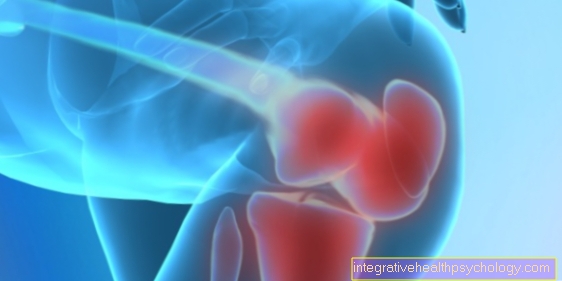Liver failure
definition
Under a liver failure (English: hepatic failure, liver failure) one understands the maximum severity of liver failure. It comes to a partial Loss of metabolic functions of the liver.
In the worst case all functions of the liver come to a standstill. At a terminal liver failure with loss of metabolic functions of the liver there is a life threatening situationthat requires immediate therapy. A hepatic coma result, which is caused by the accumulation of various metabolic products in the body.
If liver failure cannot be assigned to a cause (e.g. alcohol-toxic liver damage), it is recorded as a separate disease entity in the ICD:
- K72.0: subacute or acute liver failure
- K72.1: chronic liver failure without further specification of the cause

causes
There are many diseases and substances that can cause liver failure. Some of them lead to chronic liver damage, others acutely damage the liver. There are diseases that damage the liver tissue as well as those that hinder blood flow to the liver. Both processes lead to a destruction of the liver function and thus to a failure of the metabolic functions. A list of all conceivable causes is very difficult, so the relevant clinical pictures and substances should be mentioned here.
Inflammatory liver diseases: Hepatotropic viruses, i.e. hepatitis B, hepatitis C and hepatitis D viruses, are an important cause. These lead to chronic hepatitis (inflammation of the liver) and consequently to liver cirrhosis, which leads to liver failure. Other inflammatory liver diseases that make up only a small proportion of the total number of patients with liver failure are:
- PBC (primary biliary cirrhosis)
- PSC (primary sclerosing cholagitis)
- Autoimmune hepatitis
- parasitic infections: e.g. Leishmaniasis, malaria, schistosomiasis
Toxic liver damage: The most common cause of liver cirrhosis, which can ultimately be accompanied by liver failure, is chronic alcohol abuse. Other causes of toxic liver damage are:
- Non-alcoholic fatty liver
- Liver-toxic chemicals: certain occupational groups are exposed to hazardous substances, e.g. various plant protection products
- Liver-toxic drugs: In particular, cytotoxic drugs such as methotrexate (see: Methotrexate side effects) can severely damage the liver, but are usually necessary to combat other primary diseases such as cancer. Medicines such as Paracetamol ® or macrolide antibiotics can also be used, especially in the event of an overdose, which is usually arises out of suicidal intent, lead to acute liver failure. But then high doses are necessary for this.
- Capricorn poisoning: it contains toxins like that Amatoxin and Phallotoxinwhich can be fatal even in small amounts. One mushroom is sufficient for a moderately heavy person.
Other causes:
- Metabolic diseases: e.g. Wilson's disease, hemochromatosis, a-1 antitrypsin deficiency, or cystic fibrosis.
- Diseases of the vascular system of the liver or vascular anomalies: Due to an impairment of the blood flow to the liver, the liver function can no longer be maintained, resulting in liver failure. Mention should be made of the Budd-Chiari Syndrome and the Cirrhosis cardiaque.
- Liver cancer or liver metastases
- Heart failure, especially when the right heart is affected, can cause the blood to backflow into the liver due to the weak pump, resulting in congestive liver
Read more on the topic: Functions of the liver
Cancer as a cause of liver failure
Liver cancers are a possible cause of liver failure. Most malignant tumors of the liver are liver metastases from other primary tumors. Often there is a patient with a so-called hepatocellular carcinoma also one Cirrhosis of the liverso that liver function and remaining healthy tissue are restricted. Other cancers like Lymphoma, the cholangiocellular carcinoma or something Metastases from tumors of other organs can manifest in the liver and that Destroy liver tissue.
The malignant cancer leads to one Destruction of the liver tissue and one Worsening blood circulation of the liver cells. Especially inside HCCs (Hepatocellular carcinoma) come Areas of necrosis that arise from reduced blood flow.
The degenerate liver tissue Fulfills no more metabolic functions. Overall, the prognosis is rather poor, since advanced liver cirrhosis is often present, especially in HCC. The residual tissue that is still present, which is functional, is therefore very small and not sufficient to maintain adequate function. As a result, the therapeutic measures for advanced disease are very limited.
Alcohol as a cause of liver failure
Alcohol probably does greatest risk factor for chronic liver disease and consequently it represents liver failure. In industrialized nations in particular, massive alcohol abuse is a widespread problem. In Germany about 2.5 million alcoholics are in need of therapy.
A chronic alcohol abuse leads to one alcohol toxic liver damage. The damage can be in three stages be classified, of which the first two are potentially still reversible. The last stage, alcohol-related cirrhosis of the liver, is the Damage no longer reversible. With such advanced liver damage, liver failure can occur, as mentioned above. If all conservative and interventional therapy methods fail, then only this remains Liver transplant as a last resort.
The chronic alcohol abuse not only leads to direct damage to the liver tissue in the sense of liver cirrhosis, but also harbors this Risk of degeneration of the liver cells, from which a Liver cancer can result. This can also lead to liver failure. So there is an urgent duty to end the alcohol abuse!
Symptoms of liver failure
Acute liver failure shows a classic triad of symptoms consisting of jaundice (yellowing of the skin and sclera), coagulation disorders and impaired consciousness. This triad of symptoms results from the fact that the metabolic functions of the liver can no longer be maintained. In addition to this triad of symptoms, there are also numerous other clinical signs that indicate liver failure. In the following, the type and development of the symptoms will be discussed in more detail.
- Jaundice: Because the liver is no longer able to do that Bilirubin, which arises from the breakdown of the red blood pigment, this accumulates and leads to a yellowing of the skin and sclera, which is called Jaundice (Jaundice).
- Coagulation disorder: A coagulation disorder results from the fact that the liver can no longer perform its synthesis function of so-called coagulation factors. Therefore, there is a tendency to bleed.
- Albumin deficiency: Since no more albumin is synthesized, it results in ascites (Ascites) with sometimes massive increase in the size of the abdomen.
- Foetor hepaticus: Patients smell of raw liver from the mouth.
- Itching: Metabolic products can cause severe itching, which is particularly severe in the feet.
- Disorders of the hormonal balance: Chronic liver damage can also lead to hormonal disorders. These do not show up in acute liver failure, but are signs of a failure of liver function over a longer period of time.Mention should be made of gynecomastia (breast growth), lack of hair on the abdomen and chest in men, and menstrual disorders in women. These symptoms are caused by an estrogen / testosterone mismatch.
- Ammonia deposits: Ammonia deposits can lead to hyperventilation in the context of acute liver failure. This means that those affected breathe very quickly and shallowly. Another sign is a gross hand tremor (flapping tremor).
- Hepatic encephalopathy: A very large and important complex of symptoms of liver failure are disorders of consciousness, which are due to a hepatic encephalopathy are due. This is brain damage that occurs when toxic metabolic products such as ammonia accumulate in the brain. The hepatic encephalopathy is divided into four grades and ranges from mere disturbances of consciousness such as slight drowsiness and poor concentration to coma.
- Acute kidney failure: This is known as hepatorenal syndrome. In addition to the symptoms of liver damage, there are symptoms that can be traced back to acute kidney failure. A drop in urine excretion up to Anuria (No more urine is passed).
Cancer can also lead to liver failure. Signs of cancer are symptoms that have persisted for a long time and started rather insidiously. Mention should be made of the so-called B symptoms, in which it becomes
- Fever,
- significant unwanted weight loss and
- Night sweats come.
These symptoms are not directly related to liver failure. However, they are attributable to a liver cancer disease or liver metastases, which can ultimately lead to liver failure. Furthermore, liver tumors can cause unspecific symptoms such as loss of appetite, upper abdominal pain or jaundice (jaundice). However, the symptoms usually only show up very late in the course of the cancer.
An indication of an underlying cancer of the liver is a sudden worsening of an existing liver cirrhosis, which is known as decompensation. This is to be understood as liver failure and is associated with the above-mentioned symptoms such as ascites, impaired consciousness and jaundice.
Find out more at: Stages of cirrhosis of the liver
therapy
Liver failure represents a urgent indication for therapy It can sometimes be serious and in the worst case too serious in the case of liver failure fatal complications come because the liver fulfills vital metabolic functions that cannot be compensated by other organs. First of all, one distinguishes one symptomatic from one causal therapy of liver failure.
Symptomatic therapy

In symptomatic therapy, one tries to replace all important functions and metabolic products of the liver as far as possible and to stabilize the circulation. First of all, intensive medical monitoring is necessary, as this is an acutely life-threatening situation. The circulation is stabilized. A control of the blood sugar and a good setting of the value, as well as the substitution of important electrolytes are also essential for a stable circulation. Do not use drugs that are toxic to the liver. The intake is stopped immediately or switched to another medication. Alcohol leave is also absolutely necessary. Sufficient fluid intake and a balanced, sufficiently caloric diet are aimed for. Contrary to the old doctrine, a protein restriction in the diet is no longer recommended today. Furthermore, the following therapeutic indications result from the respective symptoms:
- Bleeding tendency: This is where coagulation factors and vitamin K are substituted.
- Portal vein hypertension: In the case of high blood pressure in the hepatic vessels, the blood pressure is lowered with drugs such as propanolol in order to avoid bleeding that occurs when so-called esophageal varices burst (esophageal variceal bleeding), which are often present in the case of liver failure due to liver cirrhosis.
- Albumin deficiency: Albumin deficiency can lead to edema and ascites. Albumin is substituted, and ascites can be punctured or treated with spironolactone medication.
- Brain edema: Here mannitol is administered and blood pressure is adjusted
- Hepatorenal syndrome: Here a drug treatment with terlipressin and albumin as well as intensive medical care takes place. A liver transplant can only be healed.
- Hepatic encephalopathy: In the mild stage (up to stage 2), only outpatient treatment is necessary. Lactulose is administered, which ultimately reduces the formation of ammonia (the cause of hepatic encephalopathy). If the lactulose therapy fails, the active ingredient ornithine aspartate is used. At an advanced stage, inpatient care is necessary. In addition to the general measures for liver failure, laxative measures and the administration of broad-spectrum antibiotics are in the foreground.
Causal (causal) therapy
The causal therapy of liver failure depends on the one responsible for it Underlying disease:
- Viral hepatitis: The aim here is antiviral therapy.
- Poisoning with drugs or poisons: It is important here to remove the toxins. This is attempted both with measures such as gastric lavage, plasmapheresis or forced diuresis as well as with specific antidotes and medication. In the case of poisoning with Paracetamol®, acetylcysteine is administered. A poisoning with the death cap mushroom is treated with penicillin and silibinin.
- Hemochromatosis: Here bloodletting is the therapy of choice.
- Wilson's disease: This is treated with chelating agents and zinc salts.
Ultimately, however, is around 50% of patients with hepatic insufficiency or failure at some point Liver transplant as healing therapy necessary. Some underlying diseases like that PBC (primary cheap cirrhosis) or the PSC (primary sclerosing cholagitis) can only be cured by this. The time to liver transplant can vary with a Liver dialysis be bridged.
At Cancer patients the therapy is based on the stage her cancer and that Degree of metastasis as well as the residual liver function. Both surgical and conservative procedures are possible. A liver transplant can only be carried out here if there is cancer without metastasis or vascular invasion.
Duration of liver failure
By definition it will be different time intervals for liver failure Are defined. The Liver failure represents the maximum form, i.e. the worst severity of liver failure This means that liver failure essentially implies liver insufficiency. The time it takes to progress to hepatic insufficiency allows the division into:
- fulminant hepatic insufficiency: Duration of less than 7 days
- acute hepatic insufficiency: duration between 7 and 28 days.
- subacute or protracted hepatic insufficiency: duration over 4 weeks
- chronic liver failure: longer duration, sometimes for months. Here, however, part of the liver function is compensated, so that liver failure only occurs when the liver functions fail and there is decompensation.

























.jpg)



